Of course she did. No word on if my local butcher will be offering cured Gaga flank steak as well.
Entries for July 2011 (August 2011 » • September 2011 » • October 2011 » • Archives)
Gaga cured her meat dress!
Super freaky dancing squid dish
This is a Japanese dish called odori-don.
A live squid with its head removed is served on top of a bowl of sushi rice, accompanied by sashimi prepared from the head (usually sliced ika (squid) and ika-kimo (squid liver)) as well as other seafood. Seasoned soy sauce is first poured on top of the squid to make it “dance”.
AGHHHH!! Gak! That is just about the freakiest thing I’ve ever seen. Delicious torture! (via mlkshk)
Rorschmap
Rorschmap is a trippy Google Maps mashup by James Bridle that provides kaleidoscopic views of locations from around the world. Here’s Paris, complete with MegaSeine.
Forty Harrison Fords
Harrison Ford has made credited appearances in 40 movies…to celebrate, the National Post had illustrator Chip Zdarsky draw portraits of Ford from each of his films.

(via @moleitau)
Audiosurf
Audiosurf is a racing game where the courses are determined by the music you play from your own library. There are all sorts of YouTube clips of the gameplay (which is reminiscent of Guitar Hero)…here’s a representative one:
Baseball symphony
Music critic Anthony Tommasini goes to a baseball game at Yankee Stadium and treats the game as a musical piece.
For all the hubbub of constant sound it is amazing how clearly the crack of a bat, the whoosh of a pitch (at least from the powerhouse Sabathia), and the leathery thud of the ball smothered in the catcher’s mitt cut through the textures. And if the hum of chattering provides the unbroken timeline and undulant ripple of this baseball symphony, the voices that break through from all around are like striking, if fleeting, solo instruments.
The most assertive soloists are the vendors. My favorite was a wiry man with nasal snarl of a voice who practically sang the words “Cracker Jack” as a three-note riff: two eighth notes on “Cracker,” followed by a quarter note on “Jack,” always on a falling minor third. (Using solf`ege syllables, think “sol, sol, mi.”) After a while I heard his voice drifting over from another section, and he had transposed his riff down exactly one step.
Updates on previous entries for Jul 28, 2011*
The most beautiful suicide orig. from Jul 16, 2008
* Q: Wha? A: These previously published entries have been updated with new information in the last 24 hours. You can find past updates here.
In Time trailer
Here’s a four-minute teaser trailer for In Time, a sci-fi action thriller directed by Andrew Niccol (Gattaca) and starring Justin Timberlake and Amanda Seyfried.
In the late 21st century, time has replaced money as the unit of currency. At 25 years old, aging stops and each person is given one more year to live. Unless you replenish your clock, you die.
Nice to see someone taking the attention economy literally. (thx, david)
Fancy old ladies
A short and charming documentary about fashionable seniors who are very much young-at-heart.
I’m not ready for a convent or anything, so I can wear leopard glasses.
If you like that, check out the portraits on Advanced Style, which is like a Sartorialist for the AARP set.
Beyond the cubicle
Allison Arieff argues that companies and their workers should worry less about office design and focus more on how people want to work.
Two other factors often undervalued (and often ignored) in the workplace? Family and time. Architect Iris Regn and artist Rebecca Niederlander have been working to bring these into the conversation by exploring the intersection between creativity and family life in an ongoing collaborative effort they call Broodwork.
Don’t be put off by the awkward name. Broodwork suggests that, far from being the hindrance it’s often presented as, incorporating family into work can have overwhelmingly positive effects. Regn is trained as an architect but is open enough in her thinking to understand that in the scheme of things, the adjustability of her desk isn’t going to have an impact on her creative process nearly as much as what her daughter might say tonight at the dinner table.
“The first impetus [of Broodwork] was to get people to acknowledge interweaving of creative practice and family life,” she told me. “Not to have to hide [your family] when you have to go pick up your kid while at a meeting, for example. That raised eyebrow is going away. Yes, you’re juggling. That’s just part of the deal. When you talk to other parents, everyone knows the deal so why is it that in a professional setting that can’t be brought to the table?
Diver face
The Telegraph has a great photo gallery of divers’ faces as they compete in diving world championships in Shanghai.

(via ★antimega)
Back in action
Photographer Joao Silva lost his legs last October when a land mine exploded under him in Afghanistan. Today, he’s back at work with a photo on the front page of the NY Times.
Although Mr. Silva can walk, he still needs a cane, which he holds in his right hand. When he wants to shoot, he must transfer the cane to his left arm so he can pick up the camera. He also conceded that he was frustrated about not yet being able to move as nimbly as he once could. But all in all, he said he was happy with his first day’s work.
“It was a matter of making the best of what I had,” he said. “There will come a time when I can run, but now I can walk.”
Modern day cargo cults
Adrian Hon cites Kickstarter & iPhone clones as evidence that cargo cult thinking is alive and well in the modern age.
Kickstarter isn’t the only success to attract cargo cults. Mere months after the iPhone was announced in 2007, a parade of competitors built their own cargo cults around it, hoping that by mimicking the iPhone’s design and its characteristic ‘apps’ they’d attract customers who don’t know any better, even if their phones didn’t have the same range of apps as Apple, or weren’t as fast.
(via waxy)
Mushroom death suit
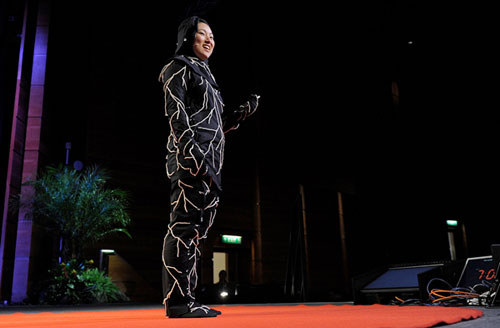
Jae Rhim Lee is growing mushrooms that will eat her body after she dies. She has also designed a special suit that will house the mushrooms as they do their work.
I am interested in cultural death denial, and why we are so distanced from our bodies, and especially how death denial leads to funeral practices that harm the environment — using formaldehyde and pink make-up and all that to make your loved one look vibrant and alive, so that you can imagine they’re just sleeping rather than actually dead. The US government recently upgraded formaldehyde from a probable carcinogen to a known carcinogen, so by trying to preserve the body we poison the living.
So I was thinking, what is the antidote to that? For me the answer was this mushroom - the Infinity Mushroom. It is a symbol of a new way of thinking about death.
El Bulli documentary
A documentary about El Bulli offers “a rare inside look at some of the world’s most innovative and exciting cooking”.
(thx, aaron)
Airbnb horror story
Airbnb is becoming a popular option for travellers looking for cheaper/homier places to stay and owners/renters to make a little dough on the side. But when you’re dealing with people that you don’t know staying in your house, things can sometimes go awry. Or very crazy:
They smashed a hole through a locked closet door, and found the passport, cash, credit card and grandmother’s jewelry I had hidden inside. They took my camera, my iPod, an old laptop, and my external backup drive filled with photos, journals… my entire life. They found my birth certificate and social security card, which I believe they photocopied - using the printer/copier I kindly left out for my guests’ use. They rifled through all my drawers, wore my shoes and clothes, and left my clothing crumpled up in a pile of wet, mildewing towels on the closet floor. They found my coupons for Bed Bath & Beyond and used the discount, along with my Mastercard, to shop online. Despite the heat wave, they used my fireplace and multiple Duraflame logs to reduce mounds of stuff (my stuff??) to ash - including, I believe, the missing set of guest sheets I left carefully folded for their comfort. Yet they were stupid and careless enough to leave the flue closed; dirty gray ash now covered every surface inside.
According to the CEO of Airbnb, they have been working with the police and supposedly a suspect is in custody.
The terroir of NYC’s tap water
New York City’s tap water used to taste of fish and cucumbers but now is some of the best tasting water in the country.
A handful of New York Times articles from the same month describe attempts to wipe out the “flavor bug,” which tastes “fishy to some palates and like cucumbers to others,” and “may even have tonic properties” despite its unpalatability. City officials began their efforts by building a bypass to cut out the Kensico reservoir at Valhalla from the New York water supply system. However, as the Times laments later in the month, “that Synura taste again taints water,” with a newly discovered colony in the Ashokan reservoir producing the “most pungent fish-and-cucumber flavor” yet recorded.
Urban evolution in NYC
Evolutionary biologists are increasingly studying organisms (like mice, fish, and bacteria) in urban areas like New York City to find out how they evolve to urban conditions.
Dr. Munshi-South and his colleagues have been analyzing the DNA of the mice. He’s been surprised to find that the populations of mice in each park are genetically distinct from the mice in others. “The amount of differences you see among populations of mice in the same borough is similar to what you’d see across the whole southeastern United States,” he said.
1896 Olympic marathon
Here’s a photo of three gentlemen running in the first Olympic marathon in 1896 attired in what looks like street clothes.
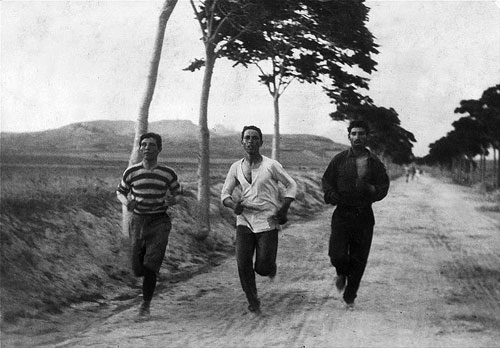
This was the second modern running of the marathon; the first was a pre-Olympic qualifying race held a month before. In the Olympic race, seventeen competitors started the race and only about half finished. The winning time was just under three hours and the third place finisher was disqualified for covering “part of the course by carriage”. I would also not be surprised if the three fellows in the photo above stopped off for a coffee and some painting along the way.
Infinite Super Mario Bros
Based on Super Mario 3, this HTML5 Super Mario game goes on forever. Someone bet Billy Mitchell he can’t finish this game and we’ll never have to hear from him again! (via waxy)
The “rules” of Monopoly
If you’ve ever played Monopoly, you probably haven’t followed the rules. The Campaign for Real Monopoly (via marco) would like to remind you of the real rules and the reasons for sticking to them.
BUYING PROPERTY…Whenever you land on an unowned property you may buy that property from the Bank at its printed price. You receive the Title Deed card showing ownership; place it face up in front of you.
If you do not wish to buy the property, the Banker sells it at auction to the highest bidder. The buyer pays the Bank the amount of the bid in cash and receives the Title Deed card for that property. Any player, including the one who declined the option to buy it at the printed price, may bid. Bidding may start at any price.
Although, as Andy Baio notes, the rules of Monopoly weren’t always the rules of Monopoly.
Contrary to popular belief, Charles Darrow didn’t invent Monopoly in 1933 from scratch. It was heavily based on The Landlord’s Game, an innovative board game patented in 1904 by Lizzie Magie, to be a “practical demonstration of the present system of land-grabbing with all its usual outcomes and consequences.”
Fluorescing tattoo for tracking body chemicals
Using a modified iPhone and a fluorescing nanoparticle tattoo, researchers at Northeastern University have found a way to monitor chemicals in the blood without drawing blood.
The team begins by injecting a solution containing carefully chosen nanoparticles into the skin. This leaves no visible mark, but the nanoparticles will fluoresce when exposed to a target molecule, such as sodium or glucose. A modified iPhone then tracks changes in the level of fluorescence, which indicates the amount of sodium or glucose present. Clark presented this work at the BioMethods Boston conference at Harvard Medical School last week.
The tattoos were originally designed as a way around the finger-prick bloodletting that is the standard technique for measuring glucose levels in those with diabetes. But Clark says they could be used to track many things besides glucose and sodium, offering a simpler, less painful, and more accurate way for many people to track many important biomarkers.
Color photos of the London Blitz
These color photos taken of London during WWII’s Battle of Britain are great.

Alan Taylor recently covered the Battle of Britain over at In Focus as well…I love this “business as usual” photo.
Bushwacker, a ballerina in hooves
Bushwacker is the top-rated bull in the US as determined by the Professional Bull Riders; he bucks riders off after an average of just under three seconds (eight seconds are needed for the rider to score points). The NY Times interviewed his trainer and some of his riders to find out why Bushwacker is so tough to ride.
Bushwacker short-hopped into the arena. Drool flew out of his mouth and whirled over Elliott’s head. Bushwacker bounded more than two feet into the air, kicked his hind legs up, and drove his front legs into the ground. Instead of waiting for his back legs to touch dirt, as most bulls do, he sprung off his front feet immediately.
This is Bushwacker’s signature move, and it is as effective in its offbeat athleticism as a point guard executing a crossover dribble to ditch a defender. Elliott came forward and lost the weight of his feet underneath him.
Possibly sensing the rider’s weight shift, Bushwacker staccato-hopped to the right. He accelerated into five successive spinning jumps. His tail whipped his own rump with emphatic snaps. Elliott flew to the right and hit the dirt. The clock showed 6.57 seconds.
Don’t miss watching the video inlined at the top of the page…Bushwacker is a total Ferdinand. And here’s video of the ride described in the passage above:
Russell Brand on Amy Winehouse
Russell Brand’s post about Amy Winehouse is a lovely tribute and a sobering reminder.
When you love someone who suffers from the disease of addiction you await the phone call. There will be a phone call. The sincere hope is that the call will be from the addict themselves, telling you they’ve had enough, that they’re ready to stop, ready to try something new. Of course though, you fear the other call, the sad nocturnal chime from a friend or relative telling you it’s too late, she’s gone.
Frustratingly it’s not a call you can ever make it must be received. It is impossible to intervene.
Could help but think of Wallace while reading this, particularly this bit:
All addicts, regardless of the substance or their social status share a consistent and obvious symptom; they’re not quite present when you talk to them. They communicate to you through a barely discernible but un-ignorable veil. Whether a homeless smack head troubling you for 50p for a cup of tea or a coked-up, pinstriped exec foaming off about his “speedboat” there is a toxic aura that prevents connection. They have about them the air of elsewhere, that they’re looking through you to somewhere else they’d rather be.
Viking colonists?
Recent analysis of some Viking bones suggests that women were a significant part of the Viking settlement of England around 900 A.D.
So, the study looked at 14 Viking burials from the era, definable by the Norse grave goods found with them and isotopes found in their bones that reveal their birthplace. The bones were sorted for telltale osteological signs of which gender they belonged to, rather than assuming that burial with a sword or knife denoted a male burial.
Overall, McLeod reports that six of the 14 burials were of women, seven were men, and one was indeterminable. Warlike grave goods may have misled earlier researchers about the gender of Viking invaders, the study suggests. At a mass burial site called Repton Woods, “(d)espite the remains of three swords being recovered from the site, all three burials that could be sexed osteologically were thought to be female, including one with a sword and shield,” says the study.
Updates on previous entries for Jul 22, 2011*
The most beautiful suicide orig. from Jul 16, 2008
* Q: Wha? A: These previously published entries have been updated with new information in the last 24 hours. You can find past updates here.
Zodiac Killer’s code cracked?
Corey Starliper believes he’s cracked the code of the 340-character cipher sent to the San Francisco Chronicle by the Zodiac Killer *and* that it identifies the killer.
Starliper split his work into two sessions of 6 hours and 3 hours. When he was done, he had decoded the following text:
KILL/SLF/DR/HELP/ME/KILL/MYSELF/GAS/CHAMBER/
AEIOUR/DAYS/QUESTIONSABLE/EVERYY/WAKING/
MOMENT/IM/ALIVE/MY/PRIDE/LOST/I/CANT/GO/ON/
LIVING/IN/THIS/WAY/KILLING/PEOPLE/I/HAV/KILLD/
SO/MANY/PEOPLE/CANT/HELP/MYSELF/IM/SO/
ANGRY/I/COULD/DO/MY/THING/IM/ALONE/IN/THIS/
WORLD/MY/WHOLE/LIFE/FUL/O/LIES/IM/UNABLE/
TO/STOP/BY/THE/TIME/YOU/SOLVE/THIS/I/WILL/
HAV/KILLD/ELEVEN/PEOPLE/PLEASE/HELP/ME/
STOP/KILLING/PEOPLE/PLEASE/MY/NAME/IS/
LEIGH/ALLEN/
Why 60 seconds and minutes but 24 hours?
Why are there 60 seconds in a minute and 60 minutes in an hour but 24 hours in a day?
Thanks to the ancient civilizations that defined and preserved the divisions of time, modern society still conceives of a day of 24 hours, an hour of 60 minutes and a minute of 60 seconds. Advances in the science of timekeeping, however, have changed how these units are defined. Seconds were once derived by dividing astronomical events into smaller parts, with the International System of Units (SI) at one time defining the second as a fraction of the mean solar day and later relating it to the tropical year. This changed in 1967, when the second was redefined as the duration of 9,192,631,770 energy transitions of the cesium atom. This recharacterization ushered in the era of atomic timekeeping and Coordinated Universal Time (UTC).
An amazing crossword puzzle
On the day before the 1996 US presidential election, the NY Times ran a crossword puzzle that correctly predicted the winner.

Click through to see how they did it.
How to fake a fingerprint
From a NY Times article on how to disappear, a quick tip on how to effectively fake a fingerprint:
Are officials troubling you for fingerprints? “There’s a nongreasy glue, like a mucilage,” he said, that is more or less invisible once applied. “You put it on your thumb. You roll your thumb over your heel. Now, you’ve got a heel print on your thumb for no one who exists.”
Frank Ahearn, one of the people quoted in the article, actually runs a business that helps people disappear…or at least he used to, until he disappeared.
Best of Damn You Auto Correct!
I’m sure a bunch of these iPhone autocorrected conversations are made-up, but I was still almost crying with laughter by the time I got to the end of the list.

Free beats
Can rap be charming? Maybe so…Chris Sullivan set up in Union Square and beatboxed so that anyone who wanted to could come up and rap:
(via @dens)
Macrophotography
This is a macro photo of…what do you think this is?

Click through to find out and see more macro photos from Caren Alpert.
Beastie Boys vs. Sesame Street
Sesame Street characters, including Grover on the flute, perform the Beastie Boys’ Sure Shot.
(via devour)
The economics of penis size
A paper authored by Tatu Westling of Helsinki University explores the relationship between the GDP growth of countries and the penile length of their residents.
The size of male organ is found to have an inverse U-shaped relationship with the level of GDP in 1985. It can alone explain over 15% of the variation in GDP. The GDP maximizing size is around 13.5 centimetres, and a collapse in economic development is identified as the size of male organ exceeds 16 centimetres.
That “U-shaped” curve…it looks like something flaccid-ish, innit? (via @atenni)
Are playgrounds too safe?
Playgrounds built in the last 20 years may be safer and result in fewer lawsuits, but the kids who use them may be missing out on some critical emotional development.
“Children need to encounter risks and overcome fears on the playground,” said Ellen Sandseter, a professor of psychology at Queen Maud University in Norway. “I think monkey bars and tall slides are great. As playgrounds become more and more boring, these are some of the few features that still can give children thrilling experiences with heights and high speed.”
After observing children on playgrounds in Norway, England and Australia, Dr. Sandseter identified six categories of risky play: exploring heights, experiencing high speed, handling dangerous tools, being near dangerous elements (like water or fire), rough-and-tumble play (like wrestling), and wandering alone away from adult supervision. The most common is climbing heights.
“Climbing equipment needs to be high enough, or else it will be too boring in the long run,” Dr. Sandseter said. “Children approach thrills and risks in a progressive manner, and very few children would try to climb to the highest point for the first time they climb. The best thing is to let children encounter these challenges from an early age, and they will then progressively learn to master them through their play over the years.”
(via @tcarmody)
nytimes.com front page time lapse
Seven-minute video of 12,000 screenshots of the front page of the NY Times website taken over a period of several months by “an errant cron task”.
What if the Potter books had been the Hermione books instead?
From Sady Doyle, an alternate history of the Harry Potter series if Rowling would have written the books from the perspective of Hermione Granger.
So, before she goes away for good, let us sing the praises of Hermione. A generation could not have asked for a better role model. Looking back over the series — from Hermione Granger and the Philosopher’s Stone through to Hermione Granger and the Deathly Hallows — the startling thing about it is how original it is. It’s what inspires your respect for Rowling: She could only have written the Hermione Granger by refusing to take the easy way out.
For starters, she gave us a female lead. As difficult as it is to imagine, Rowling was pressured to revise her initial drafts to make the lead wizard male. “More universal,” they said. “Nobody’s going to follow a female character for 4,000 pages,” they said. “Girls don’t buy books,” they said, “and boys won’t buy books about them.” But Rowling proved them wrong. She was even asked to hide her own gender, and to publish her books under a pen name, so that children wouldn’t run screaming at the thought of reading something by a lady. But Joanne Rowling never bowed to the forces of crass commercialism. She will forever be “Joanne Rowling,” and the Hermione Granger series will always be Hermione’s show.
What’s Next for Next Restaurant?
In this interview with Francis Lam, Grant Achatz drops some clues as to what the menu at Next might look like in the near future:
Chef Dave is really inspired by a children’s book right now, and our next menu can be entirely built on that. Or we can be an exact replica of another time and place. One menu might be from my memory: My first day at The French Laundry. It comes down to trying to be expressive. You can be expressive with a plate of food, or with the whole concept of a restaurant.
Another menu we’re planning is El Bulli. One course from each year from 1983 to 2003. I’d work with Ferran [Adria] to choose the dishes that he feels are his most significant; I’d need to get him on board with that.
That El Bulli menu? Fucking crazytown. And this is the third or fourth time I’ve heard about the “first day at The French Laundry” menu and every single time my mouth starts watering and my hand reaches for my wallet. (via @kathrynyu)
Fake Apple Store in China
Not content to knock-off simple iPhones and iPads, some enterprising Chinese have built an entire fake Apple Store in Kunming, China. It’s an actual store selling actual products but is obviously not affiliated with Apple in any way.

Being the curious types that we are, we struck up some conversation with these salespeople who, hand to God, all genuinely think they work for Apple.
OS X Lion is out
And as usual, the definitive review of any new version of OS X is John Siracusa’s for Ars Technica. This time around, it runs 19 pages. If that’s not to your liking, you can just download Lion right now from the Mac App Store for $30.
Two other misc Apple thoughts: 1) They appear to have discontinued the MacBook. There are Airs and Pros but no plain-old MacBooks. 2) Apple Inc, already among the largest companies in the world in terms of market cap, announced yesterday that the company’s “revenue [is] up 82 percent and profits [are] up 125 percent” over the same quarter last year. That level of growth in such a big company…that’s just astounding. And much of the revenue and profit are from products that didn’t exist even five years ago…the iPad alone was a ~$5 billion business in Q3 (for comparison, Google had $9 billion in total revenues in Q2). If that’s not unprecedented, it’s damn close.
NASA graphic standards manual from 1976
There are only a few images, but even this brief look at a mid-70s NASA graphic standards manual is tantalizing.

(via stellar)
Updates on previous entries for Jul 19, 2011*
Aaron Swartz indicted on charges of “wire fraud, computer fraud” etc. orig. from Jul 19, 2011
* Q: Wha? A: These previously published entries have been updated with new information in the last 24 hours. You can find past updates here.
Aaron Swartz indicted on charges of “wire fraud, computer fraud” etc.
Swartz is known around these parts for being a programmer, long-time blogger, early employee of Reddit, and legal enthusiast. Nick Bilton, writing for the NY Times Bits blog:
Aaron Swartz, a 24-year-old programmer and online political activist, was indicted Tuesday in Boston on charges that he stole over four million documents from the Massachusetts Institute of Technology and JSTOR, an archive of scientific journals and academic papers. (Read the full indictment.)
The charges were filed by the United States Attorney for the District of Massachusetts, Carmen M. Ortiz, and could result in up to 35 years in prison and a $1 million fine.
In a press release, Ms. Ortiz’s office said that Mr. Swartz broke into a restricted area of M.I.T. and entered a computer wiring closet. Mr. Swartz apparently then accessed the M.I.T. computer network and stole millions of documents from JSTOR.
The full indictment is here (PDF, via @delfuego). Non-PDF version is here. The whole thing is worth a read for the technical detail of how the “hack” was allegedly perpetrated:
26. This time around, Swartz circumvented MIT’s guest registration process altogether when he connected to MIT’s computer network. By this point, Swartz was familiar with the IP addresses available to be assigned at the switch in the restricted network interface closet in the basement of MIT’s Building 16. Swartz simply hard-wired into the network and assigned himself two IP addresses. He hid the Acer laptop and a succession of external storage drives under a box in the closet, so that they would not be obvious to anyone who might enter the closet. January 4 through 6, 2011
27. On January 4, 2011, Aaron Swartz was observed entering the restricted basement network wiring closet to replace an external hard drive attached to his computer.
28 On January 6, 2011, Swartz returned to the wiring closet to remove his computer equipment. This time he attempted to evade identification at the entrance to the restricted area. As Swartz entered the wiring closet, he held his bicycle helmet like a mask to shield his face, looking through ventilation holes in the helmet. Swartz then removed his computer equipment from the closet, put it in his backpack, and left, again masking his face with the bicycle helmet before peering through a crack in the double doors and cautiously stepping out.
Here’s a statement from Demand Progress, an organization founded by Swartz, about the case (via @aaronsw). This is a very different take from the indictment.
Moments ago, Aaron Swartz, former executive director and founder of Demand Progress, was indicted by the US government. As best as we can tell, he is being charged with allegedly downloading too many scholarly journal articles from the Web. The government contends that downloading said articles is actually felony computer hacking and should be punished with time in prison.
“This makes no sense,” said Demand Progress Executive Director David Segal; “it’s like trying to put someone in jail for allegedly checking too many books out of the library.”
“It’s even more strange because the alleged victim has settled any claims against Aaron, explained they’ve suffered no loss or damage, and asked the government not to prosecute,” Segal added.
James Jacobs, the Government Documents Librarian at Stanford University, also denounced the arrest: “Aaron’s prosecution undermines academic inquiry and democratic principles,” Jacobs said. “It’s incredible that the government would try to lock someone up for allegedly looking up articles at a library.”
JSTOR, the document storage service allegedly accessed by Swartz, released a statement on the case (via @delfuego):
Last fall and winter, JSTOR experienced a significant misuse of our database. A substantial portion of our publisher partners’ content was downloaded in an unauthorized fashion using the network at the Massachusetts Institute of Technology, one of our participating institutions. The content taken was systematically downloaded using an approach designed to avoid detection by our monitoring systems.
The downloaded content included over 4 million articles, book reviews, and other content from our publisher partner’s academic journals and other publications; it did not include any personally identifying information about JSTOR users.
We stopped this downloading activity, and the individual responsible, Mr. Swartz, was identified. We secured from Mr. Swartz the content that was taken, and received confirmation that the content was not and would not be used, copied, transferred, or distributed.
The criminal investigation and today’s indictment of Mr. Swartz has been directed by the United States Attorney’s Office.
As for what Swartz was planning to do with all these documents, it’s not difficult to guess…he’s done something like this before (this isn’t actually a very good guess…see the update below):
Those courts, with the help of the Government Printing Office, had opened a free trial of Pacer at 17 libraries around the country. Mr. Malamud urged fellow activists to go to those libraries, download as many court documents as they could, and send them to him for republication on the Web, where Google could get to them.
Aaron Swartz, a 22-year-old Stanford dropout and entrepreneur who read Mr. Malamud’s appeal, managed to download an estimated 20 percent of the entire database: 19,856,160 pages of text.
Then on Sept. 29, all of the free servers stopped serving. The government, it turns out, was not pleased.
A notice went out from the Government Printing Office that the free Pacer pilot program was suspended, “pending an evaluation.” A couple of weeks later, a Government Printing Office official, Richard G. Davis, told librarians that “the security of the Pacer service was compromised. The F.B.I. is conducting an investigation.”
Lawyers for Mr. Malamud and Mr. Swartz told them that they appeared to have broken no laws, noting nonetheless that it was impossible to say what angry government officials might do.
Twice bitten, indictment? Is that how the saying goes?
Update: This is a more accurate guess as to what Swartz wanted with the JSTOR documents: analyse the documents as part of his on-going work with “the corrupting influence of big money on institutions”…and *not* to free non-copyrighted information from an inefficient gatekeeper as with the PACER data. From the front page of his web site.
He is the author of numerous articles on a variety of topics, especially the corrupting influence of big money on institutions including nonprofits, the media, politics, and public opinion. In conjunction with Shireen Barday, he downloaded and analyzed 441,170 law review articles to determine the source of their funding; the results were published in the Stanford Law Review. From 2010-11, he researched these topics as a Fellow at the Harvard Ethics Center Lab on Institutional Corruption.
The Epiphanator
Paul Ford compares the neverending stories told to us by ourselves on Facebook, blogs, Twitter, etc. with the machinery of old media, which Ford calls The Epiphanator, a vast media contraption which excels at drawing conclusions.
And how do the Whole Earth heirs of Silicon Valley stand today compared to their financially bereft Epiphonatorian counterparts? Apple couldn’t get much bigger without selling oil, while the media industry has been reduced to dime-size buttons that show up on iPhone screens. Google regularly announces initiatives to “save” the newspaper and book industries — like a modern-day hunter who proclaims himself a conservationist. And Facebook, having already swallowed up enormous chunks of discretionary media consumption time, has its old-school media counterparts chasing after “Likes” as if they were cocaine being dispensed in a lab rat’s cage.
Also, Franzendentalist!
Kids show references The Wire
This scene from iCarly, a Nickelodeon show for tweens and pre-tweens, references the scene in season five of The Wire where (highlight text to show spoilers!) Michael kills Snoop.
(via @aliotsy)
The Royal Tenenbaums’ House
The Onion’s A.V. Club takes a field trip to see the Harlem house where the exteriors (and many of the interiors) were shot for The Royal Tenenbaums.
(via devour)
Google’s unusual job interview question
I feel like I’ve heard this before, but in the early days of Google, Sergey Brin ended his job interviews in an unusual manner.
Finally, he leaned forward and fired his best shot, what he came to call “the hard question.”
“I’m going to give you five minutes,” he told me. “When I come back, I want you to explain to me something complicated that I don’t already know.” He then rolled out of the room toward the snack area. I looked at Cindy. “He’s very curious about everything,” she told me. “You can talk about a hobby, something technical, whatever you want. Just make sure it’s something you really understand well.”
I wonder if Mark Zuckerberg asks similar sorts of questions on his walks in the woods.
Les Twins
I’ve seen other more formal on-stage performances by these amazing French twin dancers, but I like this one the best…even fooling around, their precision is impressive.
KWHA-sohn or crah-SONT?
Julian Dibbell quotes H.W. Fowler’s A Dictionary of Modern English Usage on the correct pronounciation of French words while speaking English.
To say a French word in the middle of an English sentence exactly as it would be said by a Frenchman in a French sentence is a feat demanding an acrobatic mouth; the muscles have to be suddenly adjusted to a performance of a different nature, & after it as suddenly recalled to the normal state; it is a feat that should not be attempted; the greater its success as a tour de force, the greater its failure as a step in the conversational progress; for your collocutor, aware that he could not have done it himself, has his attention distracted whether he admires or is humiliated.
I think that’s what Feynman was getting at here in his discussion with Murray Gell-Mann, although, in typical Feynman fashion, not in so many words.
Richard Feynman, Gell-Mann’s chief competitor for the title of the World’s Smartest Man but a stranger to pretension, once encountered Gell-Mann in the hall outside their offices at Caltech and asked him where he had been on a recent trip; “Moon-TRAY-ALGH!” Gell-Mann responded in a French accent so thick that he sounded as if he were strangling. Feynman — who, like Gell-Mann, was born in New York City — had no idea what he was talking about. “Don’t you think,” he asked Gell-Mann, when at length he had ascertained that Gell-Mann was saying “Montreal,” “that the purpose of language is communication?”
Final movie scenes
A collection of final frames from well-known movies…see if you can guess them all.

The language of Harry Potter
Worknik has a fun post up about the language of the Harry Potter books & movies.
Characters’ names are often also common words. A dumbledore is a bumblebee. Snape is a ship-building term that means “to bevel the end of (a timber or plank) so that it will fit accurately upon an inclined surface.” Hagrid is the past participle of hagride, which means “to harass or torment by dread or nightmares.” Skeeter is a term for an annoying pest, and not just Rita Skeeter, blood-sucking journalist. Mundungus is “waste animal product” or “poor-quality tobacco with a foul, rancid, or putrid smell,” a good name for a sneaky thief.
(via @djacobs)
Pixelated animal prints
Laura Bifano is selling prints of pixelated animals in her Etsy shop, like this honey badger one:
![]()
(via colossal)
Harry Potter summed up in seven minutes
If you’re headed out to see the final Potter movie this weekend, here’s a recap of the previous seven films in just seven minutes:
Tabloid’s star breaking the fourth wall
Joyce McKinney, the subject of Errol Morris’ documentary film called Tabloid, has been popping up at screenings of the film around the country, seemingly on her own dime, to conduct Q&A sessions of her own.
“I sat till the audience started to leave and waited for the precise moment, and then jumped up and yelled, ‘I’m Joyce McKinney!’” she said, with considerable glee. “They went crazy.”
There are also reports of some reviewers receiving anonymous legal threats.
Mona Lisa in 140 dots
This is pointillism taken to its limit.

Leonardo da Vinci’s ‘The Mona Lisa’ reduced & remixed down into 140 exact circles of colour. Makes no sense close up. Makes every sense from the other side of the room.
Prints are available.
Guitar string osillations caught on video
Really cool…I can see the music! (via ★than)
50 Legos
A day in the life of John Lasseter
I wasn’t going to watch all twenty-five minutes of this day-in-the-life feature about Pixar’s John Lasseter, but I got sucked in after the first two minutes for some reason and couldn’t stop. The main takeaway is that Lasseter is a relentlessly upbeat, absurdly rich, hugging, cheeseball train freak.
Watching it, I found it almost impossible to reconcile his cheeseball personality with the kind of movies that Pixar makes, except to note that the Pixar films he’s been involved with in a directorial or story capacity (Toy Storys 1-3, Cars 1-2) are the studio’s syrupiest (and Randy Newmanest). (via devour)
Happy 12th birthday, MetaFilter!
Wow, for the 12th anniversary of MetaFilter, Matt bought the domain of the first site MF ever linked to (cat-scan.com) and dedicated it to stories from the site’s early years. More here.
A typeface for dyslexics
Christian Boer designed a typeface especially for dyslexics called dyslexie.
Research by the University of Twente indicates that the typeface decreases reading errors by dyslexics.
Sunscreen explained
This infographic over at Information is Beautiful does a great job explaining the difference UV protections offered by sunscreens, what SPF is, when/how much to apply, etc. I had no idea about the stars or the difference between UVA and UVB.
Making fonts with your face
Andy Clymer of H&FJ built a prototype tool that uses facial recognition to design fonts.
(via h&fj)
Errol Morris making a movie with Paul Rudd and Ira Glass
It’s fictional but based on a This American Life story about a man whose cryogenics business goes wrong.
The film, as previously reported, is an adaptation of a 2008 report on Bob Nelson, a self-styled cryogenics pioneer. Mr. Morris claims the film, not listed on IMDB, will be written by Zach Helm, writer of the aptly titled Will Ferrell vehicle Stranger Than Fiction. This American Life previously spawned the kids’-movie adaptation Unaccompanied Minors, but Mr. Morris’s pedigree — and unique interests-promise to make this a bit more highbrow, and simultaneously more intriguingly tabloid-y.
Designy kids tattoos
Tattly is selling “designy, cool, typographic” temporary tattoos from designers including Frank Chimero, Jessica Hische, and Chris Glass.

More about Tattly at Swissmiss:
After applying many bad-clip-art tattoos on my daughter Ella, I decided to stop complaining and take matters into my own hands. I was ready to put designy, cool, typographic tattoos on my daughter, or myself for that matter. The idea for Tattly was born.
Takedown notice for monkey self-portrait
Wow. So remember the photo taken by the monkey and Techdirt’s subsequent musings about who owns the copyright a photo taken by a monkey? Today Techdirt is reporting that Caters News Agency sent a takedown notice to Techdirt asking them to remove the monkey’s photos. Totally not making this up.
We were a bit surprised to receive a notice on Monday from Caters News, telling us they represented David Slater with respect to the syndication of those photos, and asking us to take down the photos. The notice was not a DMCA takedown notice. It doesn’t even mention copyright, though that seems like the only basis upon which they would make such a takedown request. And, to be clear, it was not in the least bit threatening. There is no legal language and no threat at all in the note.
When asked for clarification by Techdirt, a representative from Caters replied:
Michael, regardless of the issue of who does and doesn’t own the copyright — it is 100% clear that the copyright owner is not yourself. You have blatantly ‘lifted’ these photographs from somewhere — I presume the Daily Mail online. On the presumption that you do not like to encourage copyright theft (regardless of who owns it) then please remove the photographs.
Onionesque. Please someone interview the monkey about his/her views on this.
You can 3-D print working tools now
Did you know 3-D printers could make complex objects with moving parts like gears and crescent wrenches? I had no idea…this is kind of mind-blowing. The guy at the beginning likens the technology to Star Trek’s replicator.
Slopegraphs
Charlie Park takes a look at a type of chart that Edward Tufte developed for his 1983 book, The Visual Display of Quantitative Information. Unlike sparklines, another Tufte invention/coinage, slopegraphs didn’t really take off.
It’s curious that it hasn’t become more popular, as the chart type is quite elegant and aligns with all of Tufte’s best practices for data visualization, and was created by the master of information design. Why haven’t these charts (christened “slopegraphs” by Tufte about a month ago) taken off the way sparklines did? In this post, we’re going to look at slopegraphs — what they are, how they’re made, why they haven’t seen a massive uptake so far, and why I think they’re about to become much more popular in the near future.
Rave on, Internet
NPR has an interesting piece on how the internet shaped the American rave scene in the 90s.
At first, the connections were done the old-fashioned way. “By 1994, there was already kind of an established network of party-throwers and partygoers [in Detroit],” says Rob Theakston, a Detroit rave veteran. “At that point, the scene was maybe 200 kids max. Everything was very phone-based. [You’d] call the phone lines the day of to get directions, and even then, a lot of the direction lines would just give the vicinity because you would already know: ‘Oh, Harper and Van Dyke — that’s the old theater. We know where the party’s going to be.’ They wouldn’t give you the exact address for the authorities to find out.”
(via @moth)
Ten hour videos
YouTube user TehN1ppe has been uploading a series of 10-hour repetitive videos. Here’s Super Mario climbing a vine for ten hours in a row:
There’s also epic sax guy playing for 10 hours, badger badger (mushroom! mushroom!) for 10 hours, 10 hours of Tetris, 10 hours of the Inception horn, 10 hours of vuvuzela, and, oh my yes, 10 hours of Hypnotoad.
Somehow, these aren’t even close to the longest videos on YouTube…here’s one that plays for 518 hours (more than 21 days).
The Xbox version of Dock Ellis’ LSD-fueled no-hitter
In 1970, professional baseballer Dock Ellis, who was good at pitching baseballs, threw a no-hitter while under the influence of LSD. In 2011, professional blogger A.J. Daulerio, who isn’t so good at video game baseball, attempted to throw a no-hitter while on LSD…playing a customized Dock Ellis in MLB 2K11 on Xbox.
But by the fourth game I started to pick up tendencies in all the batters. Jason Bartlett swung at first-pitch changeups. Will Venable couldn’t hit the palm ball. In fact, most of these free-swinging Padres couldn’t hit Dock’s funky palm ball. I threw it often. But by then, also, the first acid distractions entered: the TV flickered; the cracks in the wall started to move; the hand soap started to breathe — those sorts of things. Plus I was drawn to the outdoor garden between innings. Rain was near, I sensed.
Time capsule: photos of the 1989 Oscars
Alan Light got himself invited to the Academy Awards in 1989 with full access privileges…he took along a camera and shot dozens of candid photos of celebrities on the red carpet, at rehersals, and at after-parties. Here are Drew Barrymore and Corey Feldman arriving:
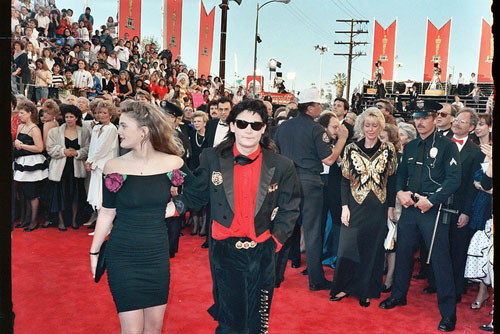
Barrymore, 14, and Feldman, 17, were dating at the time. At this point, Barrymore had been in rehab twice for drugs/alcohol and is two months away from a failed suicide attempt. Light also got photos of Lucille Ball a month before she died, Tom Cruise and Mimi Rogers, Mayim Bialik, Jodie Foster (who won the Best Actress Oscar that year for The Accused) and, my favorite for some reason, River Phoenix.
Lou Gehrig and how to die
Dudley Clendinen has ALS, aka Lou Gehrig’s disease, and has a short time to live. Which is fine by him; he’s got a plan.
There is no meaningful treatment. No cure. There is one medication, Rilutek, which might make a few months’ difference. It retails for about $14,000 a year. That doesn’t seem worthwhile to me. If I let this run the whole course, with all the human, medical, technological and loving support I will start to need just months from now, it will leave me, in 5 or 8 or 12 or more years, a conscious but motionless, mute, withered, incontinent mummy of my former self. Maintained by feeding and waste tubes, breathing and suctioning machines.
No, thank you. I hate being a drag. I don’t think I’ll stick around for the back half of Lou.
I think it’s important to say that. We obsess in this country about how to eat and dress and drink, about finding a job and a mate. About having sex and children. About how to live. But we don’t talk about how to die. We act as if facing death weren’t one of life’s greatest, most absorbing thrills and challenges. Believe me, it is. This is not dull. But we have to be able to see doctors and machines, medical and insurance systems, family and friends and religions as informative - not governing - in order to be free.
And that’s the point. This is not about one particular disease or even about Death. It’s about Life, when you know there’s not much left. That is the weird blessing of Lou. There is no escape, and nothing much to do. It’s liberating.
Goodbye to the possibilities of knee tapping
File this one under “sobbing at work”…Paul Ford shares the story of his and his wife’s efforts to conceive a child in this age of mechanical reproduction.
We don’t tell many people about what we are doing. When we do some say: “Well, it must be fun trying.” Or: “Are sure you’re doing it right?” I laugh with them; after all, how many times have I said something insensitive while trying to be funny? I don’t talk about the large doses of medicine that I inject into my wife’s buttocks that cause her to inflate like a hormonal balloon. Nor do I discuss how intimacy itself has become such an awkward, uncomfortable thing that it’s scheduled on a Google Calendar named “LadyStuffings” with events that show up in pink.
Paul, I wish you way more than luck.
The Stanford prison experiment, 40 years later
For the Stanford alumni magazine, Romesh Ratnesar interviewed some of the participants of the Stanford prison experiment for the 40th anniversary of the event. Here’s Philip Zimbardo, the leader of the study:
After the end of the first day, I said, “There’s nothing here. Nothing’s happening.” The guards had this antiauthority mentality. They felt awkward in their uniforms. They didn’t get into the guard mentality until the prisoners started to revolt. Throughout the experiment, there was this conspiracy of denial-everyone involved was in effect denying that this was an experiment and agreeing that this is a prison run by psychologists.
There was zero time for reflection. We had to feed the prisoners three meals a day, deal with the prisoner breakdowns, deal with their parents, run a parole board. By the third day I was sleeping in my office. I had become the superintendent of the Stanford county jail. That was who I was: I’m not the researcher at all. Even my posture changes-when I walk through the prison yard, I’m walking with my hands behind my back, which I never in my life do, the way generals walk when they’re inspecting troops.
(via @tylercowen)
Dean Martin’s burger recipe
From The Celebrity Cookbook (1967), Dean Martin’s recipe for hamburgers:

No ice. TV tray. Classy. (via @lettersofnote)
The Star Wars blueprints
Star Wars: The Blueprints is a $500 limited edition book that contains photographs and illustrations about how the Star Wars movies wre created.
Star Wars: The Blueprints brings together, for the first time, the original blueprints created for the filming of the Star Wars Saga. Drawn from deep within the Lucasfilm Archives and combined with exhaustive and insightful commentary from best-selling author J. W. Rinzler, the collection maps in precise, vivid, and intricate detail the very genesis of the most enduring and beloved story ever to appear onscreen.
Star Wars: The Blueprints gives voice to the groundbreaking and brilliant engineers, designers, and artists that have, in film after film, created the most imaginative and iconic locales in the history of cinema. Melding science and art, these drawings giving birth to fantastic new worlds, ships, and creatures.
Most importantly, Blueprints shows how in bringing this extraordinary epic to life, the world of special effects as we know it was born. For the first time, here you will see the initial concepts behind such iconic Star Wars scenes as the Rebel blockade runner hallways, the bridge of General Grievous s flagship, the interior of the fastest hunk of junk in the Galaxy, and Jabba the Hutt’s palace. Never before seen craftsmanship and artistry is evident whether floating on the Death Star, escaping on a speeder bike, or exploring the Tatooine Homestead.
And hey, Amazon’s got it for only $450.
Arrested Development = The Godfather!
Basically, Arrested Development is a sitcom version of The Godfather. Michael = Michael, G.O.B. = Sonny, and Fredo = Buster.
Fredo Corleone is the second oldest son of Don Vito Corleone, but is unfit to run the family business. His stupidity, lack of confidence, and otherwise child-like behavior prevent him from being taken seriously by any member of the family. Despite his attempts at success, integration into the family usually comes to no avail. He is often humored by deciding family members (Michael), and given menial business tasks (i.e. casinos, whorehouses) for the family.
Buster Bluth is the youngest son of George, Sr., and is unfit to run the family business. His stupidity, lack of confidence, and otherwise child-like behavior prevent him from being taken seriously by any member of the family. Despite his attempts at success, integration into the family business usually comes to no avail. He is often humored by deciding family members (his mother), and given menial tasks (i.e. learning cartography) to distract him.
(via mlkshk, sorta)
A history of the Space Shuttle in pictures
From earlier this month at In Focus, a photographic look at the “dizzying inspiration and crushing disappointment” of NASA’s Space Shuttle program. (via @robinsloan)
Talking Funny
Who knows how long this is going to be up because it doesn’t appear to be from a legit source, but Talking Funny, a one-hour HBO special featuring Ricky Gervais, Louis C.K., Chris Rock, and Jerry Seinfeld talking about comedy, is available on YouTube in four parts. Here’s part one to get you going:
What would Don Draper do?
A flowchart from The Oatmeal on what Don Draper might do when confronted with a problem.
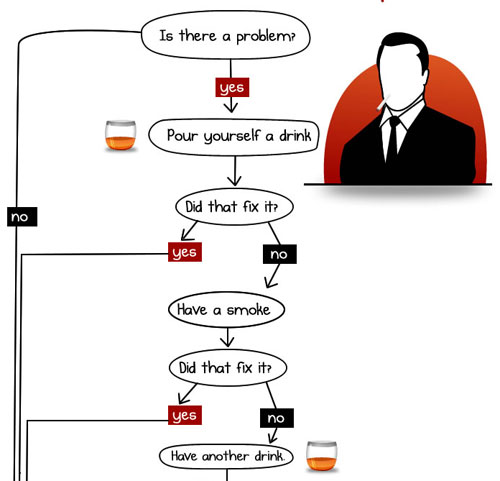
(thx, toni)
What the hell is a singing bird pistol?
Christie’s recently sold a pair of matching singing bird pistols at auction for $5.8 million. The objects themselves are impressive and nutty.
(thx, raza)
Fastest possible drawings of everything
Who owns the copyright on a photo taken by a monkey?
I almost made a joke on this post about getting a takedown notice from the monkey who took the inlined image, but this story on Techdirt explores the copyright issues involved in a more serious way.
Technically, in most cases, whoever makes the actual work gets the copyright. That is, if you hand your camera to a stranger to take your photo, technically that stranger holds the copyright on the photo, though no one ever enforces this.
(via ★tcarmody)
A book launch gone wrong
Author Alex Shakar shares the story of the sale of his first book. It went for low-to-mid six figures to a great editor, the marketing was tight, reviews were rave, and then…well, I won’t spoil it for you.
I would have felt blessed to work with any of editors I’d met that week, but Robert was my first choice, and Bill’s as well. Robert, though, left nothing to chance. He was the highest bidder at auction, consenting to be turned upside-down and shaken for change. At day’s end, after Bill told me the final figure on the phone, I wandered numb out of the special ed teacher’s apartment and up St. Marks to the subway. I was having dinner with two of my closest friends from college, also aspiring writers, one of whom had been gifted by a grandparent a coupon good for two free entrees at a Ruth’s Chris steakhouse, our plan being to split the cost of the third. I couldn’t bring myself to tell them how much money I’d just made. I said it was a lot. Then I kind of laughed. Then I said it was a whole lot. There was an uncomfortable silence as we all realized I wasn’t going to get more specific.
That book, The Savage Girl, is available at Amazon.
Daily levitation self-portraits
Even though several photographers have done similar projects (e.g. Denis Darzacq), these levitating self-portraits by Natsumi Hayashi charmed the pants right off of me.

Updates on previous entries for Jul 6, 2011*
In Next, the seeds of Apple orig. from Jul 06, 2011
* Q: Wha? A: These previously published entries have been updated with new information in the last 24 hours. You can find past updates here.
The complete Harry Potter, in comic form
Epic comic version of all eight of the Happy Potter movies by Lucy Knisley.
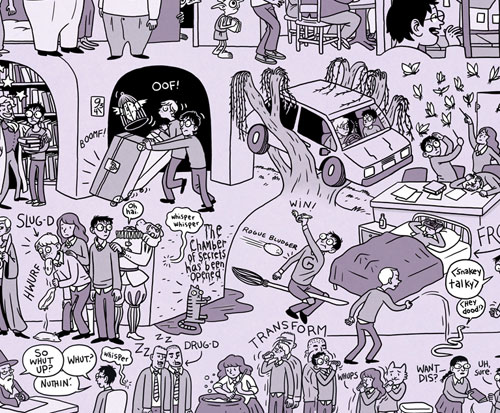
Knisley is also offering large format images of the comic for personal use…for a limited time only.
How to beat a chess grandmaster
Watch as magician Derren Brown beats a room full of grandmasters and other top chess players even though he doesn’t really play chess all that well. At the end, he explains how he did it…it’s a dead simple clever method.
In Next, the seeds of Apple
From 1990, a NY Times article on a new factory built by Next, the company Steve Jobs started after he left Apple. The more you learn about Next, the more you realize just how much Next DNA there is in the current incarnation of Apple. The story of Apple’s second coming could easily be written as the triumph of Next. This section from the middle of the article articulates perfectly Apple’s current approach to manufacturing:
Indeed, critics of Mr. Jobs, who is 35 years old, say he is wasting his money by building a factory at this point. With the small number of machines he is building today, it would have been cheaper simply to contract with other companies to assemble the computers, they say.
But Dr. Piszczalski said the initial high investment in an automated factory may permit Next more control of its expenses while volumes are low.
And backers of Mr. Jobs note that he has a long-term strategy in which manufacturing makes sense. “Steve will be in business for the long pull,” said H. Ross Perot, one of Next’s investors. “He’s not in business for six months.”
Next’s products have yet to gain a significant share of the marketplace, but Mr. Jobs, who has a reputation for painstaking attention to detail and a passion for the importance of manufacturing, argues that by linking this flexible factory more closely than ever to Next’s research and development process, his company can gain a strategic advantage in the industry that will eventually pay off in larger sales.
In Mr. Jobs’s view, the factory testifies to the fact that the United States can still compete as both a low-cost and a world-class manufacturer when it sets its mind to the task.
Mr. Jobs said he modeled the factory after those of Japanese corporations like the Sony Corporation that have perfected a design-for-manufacturing strategy that transforms the factory floor into an extension of the company research and development center.
Update: Next made a documentary on how computers are made at the new factory.
That’s got to be a Hans Zimmer soundtrack, yes? (via @mgrdcm)
Best introductory books
A site that provides the best introductory books for dozens of topics. (thx, david)
Monkey self-portraits
Forget the million monkeys at a million typewriters eventually pounding out Shakespeare. Watch out Cartier Bresson (or perhaps Jill Greenberg), they’ve moved on to photography. A crested black macaque grabbed a photographer’s camera and shot dozens of shots, including this fine self-portrait:

I think that is my new favorite photo by my new favorite photographer.
Keeping language alive through texting
Young people in Chile, the Phillipines, and Mexico are using endangered regional languages to communicate and express themselves online and via text messaging.
Herrera also discovered teens in the Phillippines and Mexico who think it’s “cool” to send text messages in regional endangered languages like Kapampangan and Huave. Almost as soon as text messaging exploded on the world stage as a means to reach anyone, anywhere, and anytime, young people began to find a way to scale it back, make it more exclusive and develop their own code or doublespeak to use on the widely used devices.
(via @tcarmody?)
Texters
From Joe Holmes, Texters, a photo series of people texting.

Mark Zuckerberg’s adult supervision
In the latest issue of the New Yorker, Ken Auletta has a profile of Sheryl Sandberg, COO of Facebook. A lot of the article focuses on gender issues in business and technology.
Early this spring, Sandberg gathered twelve female Facebook executives in a bare, white-walled conference room to review the agenda for the company’s Women’s Leadership Day, which was scheduled for the following week. Each of them was expected to lead sessions encouraging all the female executives there to step up “into leadership” roles. “What I believe, and that doesn’t mean everyone believes it, is that there are still institutional problems and we need more flexibility in all of this stuff,” Sandberg told them. “But much too much of the conversation is on blaming others, and not enough is on taking responsibility ourselves.”
Yes, she continued, we could swap anecdotes about sexist acts. But doing so diverts women from self-improvement. She opposes all forms of affirmative action for women. “If you don’t believe there is a glass ceiling, there is no need,” she told me. She doesn’t even like voluntary efforts to keep positions open for qualified women. There’s a cost, she explained, in lost time, and a cost for women, because “people will think she’s not the best person and that job was held open for a woman.”
Engineered geometric typefaces
I love these two related typefaces by Klim Type Foundry: Metric and Calibre.

Metric & Calibre are a pair of typefaces that share a fundamental geometry yet differ in the finish of key letterforms. Metric is a geometric humanist, sired by West Berlin street signs. Calibre is a geometric neo-grotesque, inspired by the rationality of Aldo Novarese’s seldom seen Recta. They were conceived as a pair but function independently of each other.
The development of Metric & Calibre is based upon two ideas-1: “engineered geometry” and it’s application to street signage, 2: alternate letterforms in typefaces.
(via df)
Intentionally flawed goods
Artist Jeremy Hutchison commissioned a series of intentionally incorrect products from factories around the world.
“I asked them to make me one of their products, but to make it with an error,” Hutchison explains. “I specified that this error should render the object dysfunctional. And rather than my choosing the error, I wanted the factory worker who made it to choose what error to make. Whatever this worker chose to do, I would accept and pay for.”
Hutchison received a comb without tines, the ordering of which prompted a letter from the confused factory rep:
I have read your email, which makes me confused. As you know, combs shold be fabricated correctly and customers should like to buy combs which can comb hair. However, from your words, it seems you need us to fabricate combs incorrectly and combs can not comb the hair. I can not understand this well. Pls kindly explain detailedly.
There is also a Magritte-esque pipe with no place to put tobacco, and these impractial sunglasses:

(via @kevmaguire)
Did Columbus cause The Little Ice Age?
I’m slowly working my way through Charles Mann’s 1493 and there are interesting tidbits on almost every page. One of my favorite bits of the book so far is a possible explanation of the Little Ice Age that I hadn’t heard before put forth by William Ruddiman.
As human communities grow, Ruddiman pointed out, they open more land for farms and cut down more trees for fuel and shelter. In Europe and Asia, forests were cut down with the ax. In the Americas before [Columbus], the primary tool was fire. For weeks on end, smoke from Indian bonfires shrouded Florida, California, and the Great Plains.
Burning like this happened all over the pre-Columbian Americas, from present-day New England to Mexico to the Amazon basin to Argentina. Then the Europeans came:
Enter now the Columbian Exchange. Eurasian bacteria, viruses, and parasites sweep through the Americas, killing huge numbers of people — and unraveling the millenia-old network of human intervention. Flames subside to embers across the Western Hemisphere as Indian torches are stilled. In the forests, fire-hating trees like oak and hickory muscle aside fire-loving species like loblolly, longleaf, and slash pine, which are so dependent on regular burning that their cones will only open and release seed when exposed to flame. Animals that Indians had hunted, keeping their numbers down, suddenly flourish in great numbers. And so on.
The regular fires and forest regrowth resulted in less carbon dioxide in the atmosphere and the atmosphere traps less heat. It’s like global warming in reverse.
Fastest driven lap around Manhattan
This guy drove the entire way around Manhattan (24 miles) in just 26 minutes, averaging 56 miles/hour and topping out at 111 miles/hour.
Someone left this typically New York comment:
I am an NYC cab driver and I promise I could beat this record in my crown Victoria. Simple factors that are unaware to the civilian driver the cabby knows. This cabby knows to drive sunday night when theres no construction work being done, this cabby knows what speed to maintain to time the lights on the westside highway and this cabby knows the quickest way from the FDR to the West side highway.
(via ★fakeisthenewreal)
Little adults
Anna Skladmann takes photographs of the children of rich Russian families.

When I came to photograph Eva, she was at home with her two nannies, one British and one Russian. She had planned everything in advance: the dress she had chosen hung already perfectly ironed and pressed with matching tights and shoes carefully next to it. I felt that I had been hired by Eva to do this shoot rather than the other way around. She was experienced and knowledgeable as she showed me the rooms we were allowed to photograph. She placed herself carefully on the edge of a couch, stood in front of her favorite painting, and posed in her parents’ library. At the end of this photo session she was exhausted and lay down on the sofa. Finally I was able to take the only photograph that I had composed myself.
Updates on previous entries for Jun 30, 2011*
Restoring an 1870s photograph orig. from Jun 30, 2011
Oxford Writing and Style Guide no longer recommending the Oxford comma orig. from Jun 29, 2011
* Q: Wha? A: These previously published entries have been updated with new information in the last 24 hours. You can find past updates here.

